We are all familiar with the dashboard of our car showing the low oil light.
Now you can choose to ignore the low engine oil signal, but what are the consequences? Remember the functions of motor oil–lubricates moving engine parts, reduces the chance of friction, which can damage your engine, maintains engine power, prevents as well as removes harmful deposits in your engine.
This results in better engine performance and fuel efficiency. It also cools those engine parts not cooled by radiator coolant and provides protection from corrosion. If you happen to be in a boat and you run out of oil, your engine seizes up and you are dead in the water. The same result can occur if you are on the highway, and then you are simply an accident waiting to happen!
Let’s say you decide to change the oil to avoid a disaster. What kind of oil do you put in your vehicle and how much? Using the wrong oil, wrong amount will surely be followed by poor performance.
Most of us take better care of cars then we do ourselves. Do you know your (fish) oil level? Is your fish oil the right one for your body? Is it in balance with the other oils of the body? Where does your body obtain fish oil? Are all the oils the same? What affects how the oil is metabolized? When the oils are insufficient or not in balanced, how does it affect your life and the risk of various diseases? How often should you determine you oil levels?

Wouldn’t it be convenient if we could put a little dip stick in a blood vessel and it told us, “You are low in Omega-3 fatty acids. Eat 3 servings of fish a week!”
But it is not that simple, as I will point out later.
Let’s start with the basics!
What are Omega-3 fatty acids?
Omega-3 fatty acids are called essential fatty acids because even though the human body, like all other mammals, is incapable of the acid production, it forms an integral part of all the human metabolic processes.
Sources of Omega-3 Fatty Acids
This essential group of nutrients is found in some plants and animals only. Fish such as herring, halibut, clam, tuna, sardine, salmon, mackerel and shrimp are rich in EPA (eicosapentaenoic acid) and DHA (docosahexaenoic acid) ALA (alpha linolenic acid) is mostly found in plant sources like soybeans, walnuts, flaxseeds, sunflower seeds, nuts and green vegetables.
Below is a summary of fatty acids:
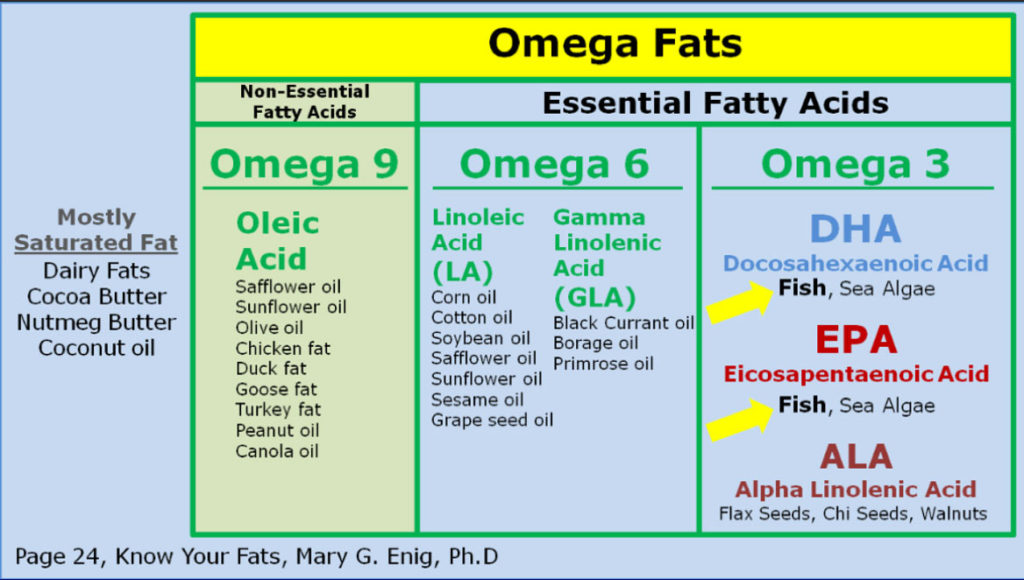

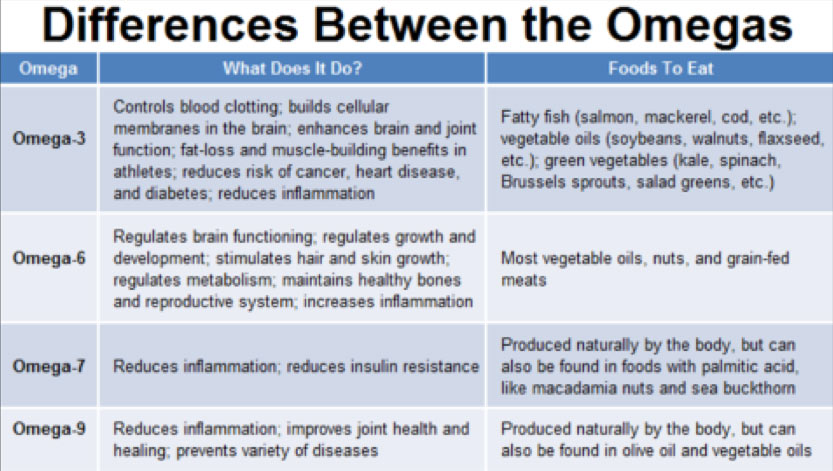
What do Omega-3 fatty acids do? (1)
They do quite a bit!
- Supply energy to the body
- Contain raw materials that help control blood pressure, blood clotting, inflammation and other body functions
- Provide storage and insulation
- Promote healthy skin, hair, and nails
- Help in the absorption and transport of the fat soluble vitamins A, D, E, and K through the bloodstream
- Help control behavior and mood
Since we don’t have a dashboard with a light coming on telling us our oil is low, how do we know? It is based on symptoms. However, symptoms alone cannot identify the problem. For example, too much or too little in whatever form can lead to disease and the balance of the various fats are critical features that determine how fat contributes to a given disease. (1)
Listed below are symptoms associated with abnormal fatty acid metabolism:
- Dry skin
- Fatigue
- Dry, unmanageable hair
- Irritability
- Dry eyes
- Attention deficit
- Dandruff
- Allergies
- Alligator skin
- Lowered immunity
- “Chicken skin” on back of arms
- Learning problems
- Cracked skin on heels or fingertips
- Poor wound healing
- Patches of dry skin on cheeks
- Frequent infections
- Brittle, easily frayed nails
- Excessive thirst
- Frequent urination
- Hyperactivity (1)
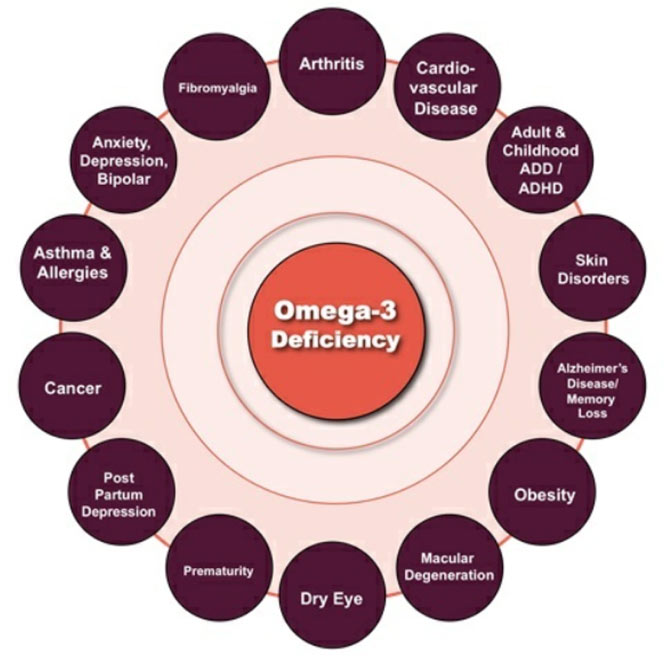
The two primary essential fatty acids (EFA’s) are linoleic acid (Omega -6s) and alpha-linolenic (Omega-3). Don’t worry about the complicated names, just remember Omega-6 and Omega-3.
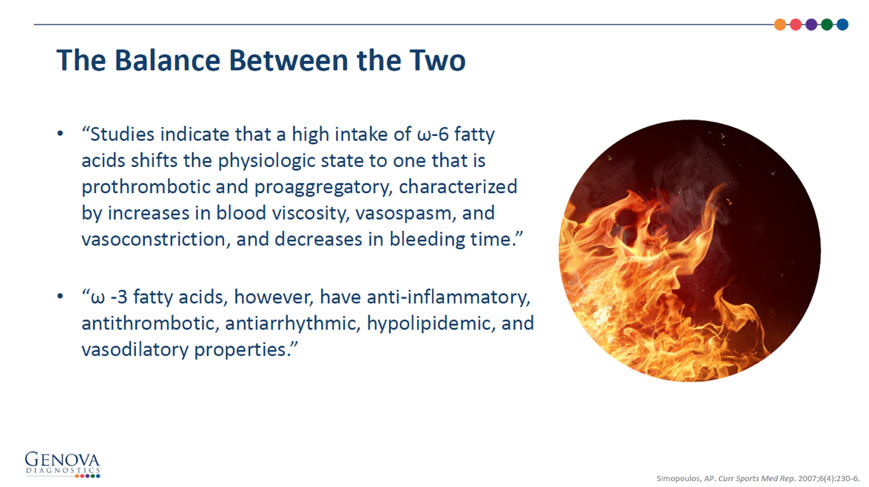
These symptoms do make the diagnosis! You must be tested! It has been my experience that the best test is the HS Omega-3 Index.
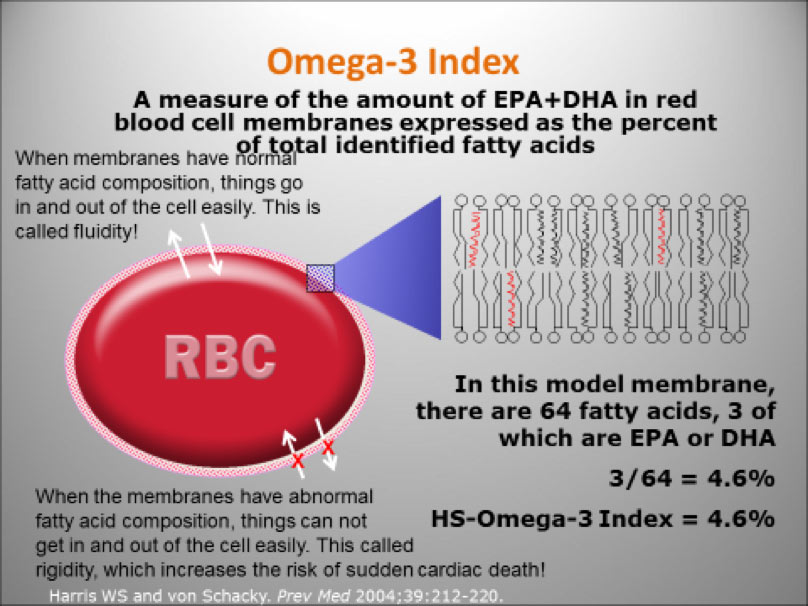
Every cell of the body is surrounded by a double layer of fat. In the fatty membrane are Omega-6 and Omega-3 fatty acids (the reds are the Omega-3s).
The right combination of Omega-6 and Omega-3 is referred to as the Omega-3 Index. If the ratio is optimal, various chemicals, nutrients, and hormones enter and other chemicals exit the cell easily. This is called fluidity. If the ratio is inappropriate, chemicals required for normal cell function, nutrients and hormones cannot enter the cell to ensure that cell is functioning at an optimal level. This is called rigidity and increases the risk of numerous conditions. Look at the diagrams below. What is the optimal ratio of Omega-6 to Omega-3?
The ideal ratio between Omega-6 and Omega-3 fats in EFAs is estimated to be 3:1 to 5:1. The average American’s ratio is more like 25:1, thanks to diets heavy in processed vegetable oils.

The Omega-3 Index is a better predictor of sudden cardiac death, better than blood cholesterol and even cholesterol fractions of LDL and HDL. It’s also better than blood triglycerides or homocysteine levels as far as predicting heart attacks and at least as good as other popular tests for assessing the risk for non-fatal heart attacks.
Earlier, I mentioned that when your engine in your car or boat runs out of oil, it seizes up and dies! If you have a very low Omega-3 Index, your heart seizes up and you are at risk of sudden cardiac death!
A higher Omega-3 Index was associated with slowed “cellular aging” as measured by the five-year rate of telomere shortening.
Heart patients with below average Omega-3 Index values died at a faster rate than those with above average levels. Patients admitted to the hospital with an acute MI are less likely to develop ventricular arrhythmias if they have a higher versus a lower Omega-3 Index!
A lower Omega-3 Index was associated with depression, both in adolescent patients and in post ACS (acute coronary artery syndrome) patients. A slower heart rate was related to a higher Omega-3 Index. (2)
In our study, those with an Omega-3 Index of about 8% “aged” at less than half the rate as those with an Index of 3%. (3)
Has your health care provider determined your Omega-3 Index? If not, don’t just ask for the test, insist on it!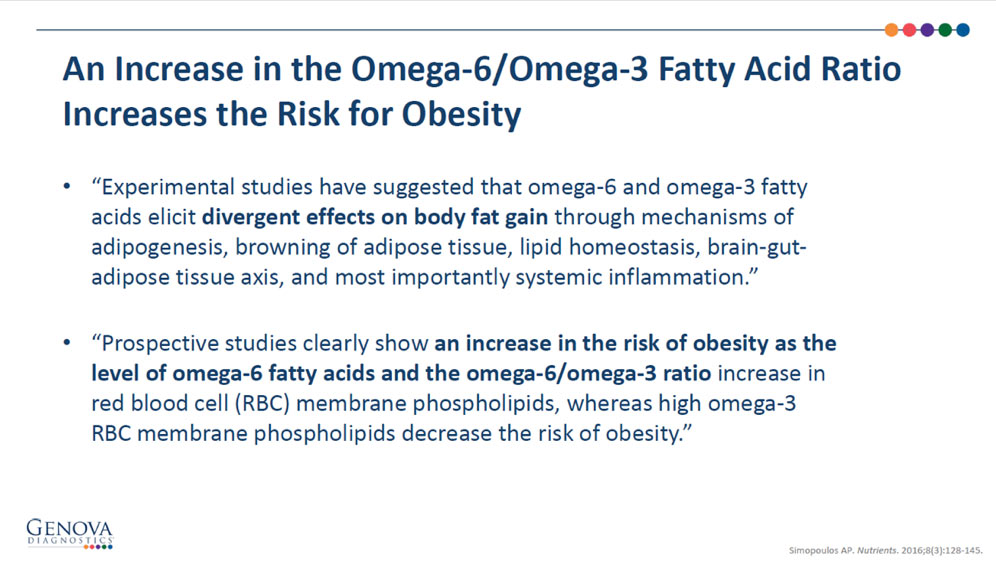

This article doesn’t say total or LDL cholesterol reduces primary cardiac arrest! It is the Omega-3 content.
Unfortunately, simply eating more Omega-3 rich fish or taking fish oil supplements will not tell you exactly what impact that will make until you have had your Omega-3 Index measured.
This study indicates that maternal vitamin D deficiency increases fatty acid desaturase activity (delta 5) expression and therefore alters maternal fatty acid metabolism. This results in an increase in inflammation. (4)
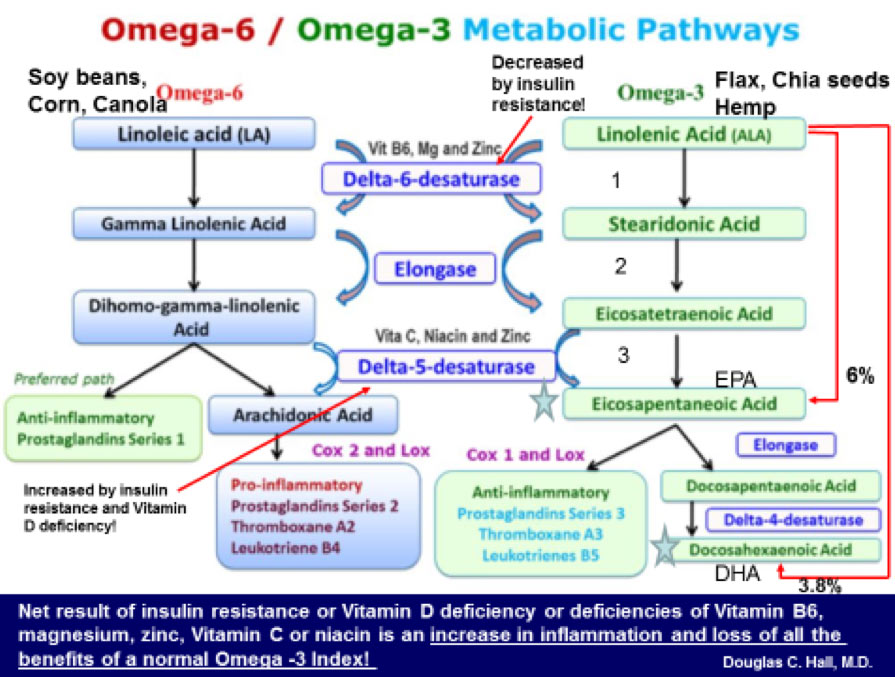
Look at how little flax is converted to EPA (6%) and DHA (3.8%)! So you should not count on flax to supply you with adequate amounts of EPA and DHA. Look at the nutrients required for adequate production of EPA and DHA from flax, chia seeds and hemp. Lack of these nutrients, will convert your linolenic acid to pro-inflammatory chemicals. The first enzyme (delta-6-desaturase) is inhibited by excess insulin and the second enzyme (delta-5-desaturase) is increased by excess insulin and vitamin D deficiency. So again, you convert your linolenic acid to pro-inflammatory chemicals and your health deteriorates!
It is not what you take that makes a difference! It is what you make!I know this is difficult, but this is your life! You can’t assume because you are taking a “fish oil supplement or eating fish three time a week” that you are OK. You must be tested!

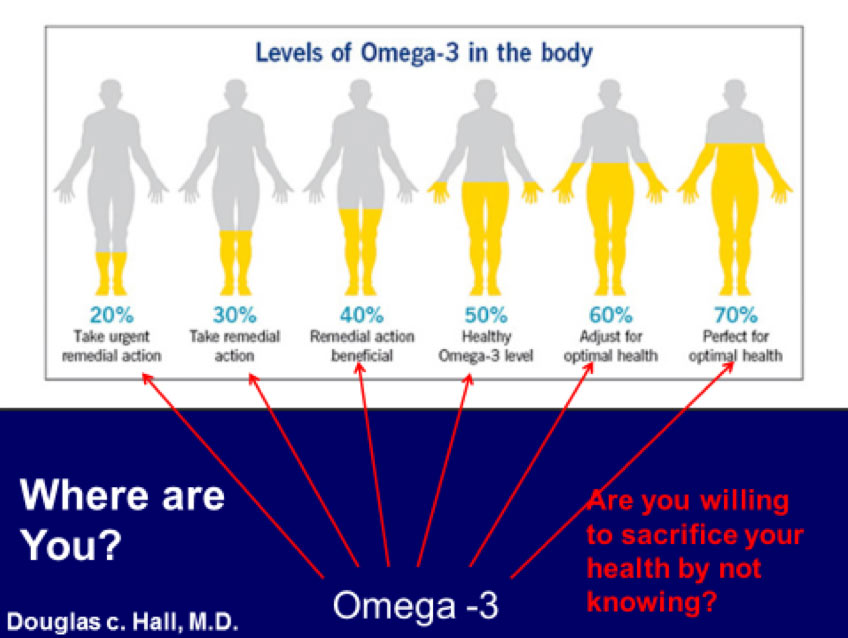
Don’t guess if you have the optimal levels of Omega-3 fatty acid, TEST!
What are the requirements of an ideal Omega-3 supplement?
- Toxin-free: No heavy metals, no microbiological contamination, no rancidity, no plastics, packaged in dark or opaque bottles
- Pharmaceutical grade: no oxygen exposure processing, no peroxidation or peroxidation end-products
- Antioxidants: to protect and stabilize fatty acids from peroxidation
- Third party tested: To ensure what the label says is really in the bottle
My most successful product has been MonoPure from Xymogen.
Isn’t it time to check your oil?
- Essential Fatty Acids Absorption and Metabolism by Deanna Minich, Ph.D
- http://www.drpasswater.com/nutrition_library/William_Harris.html William Harris, Ph.D
- JAMA 2010;303:250-257
- Prostaglandins Leukot Essent Fatty Acids. 2019 Jan;140:57-63

About the Author
Douglas C. Hall, M.D.
Dr. Douglas Hall, was born in Indianapolis, Indiana on Jan. 30, 1941. He received his BS and Doctor of Medicine at the University of Florida, training in obstetrics and gynecology. Dr. Hall has been in private practice since 1974 and currently has a large practice in Ocala, specializing in OB/GYN and Functional Medicine.


